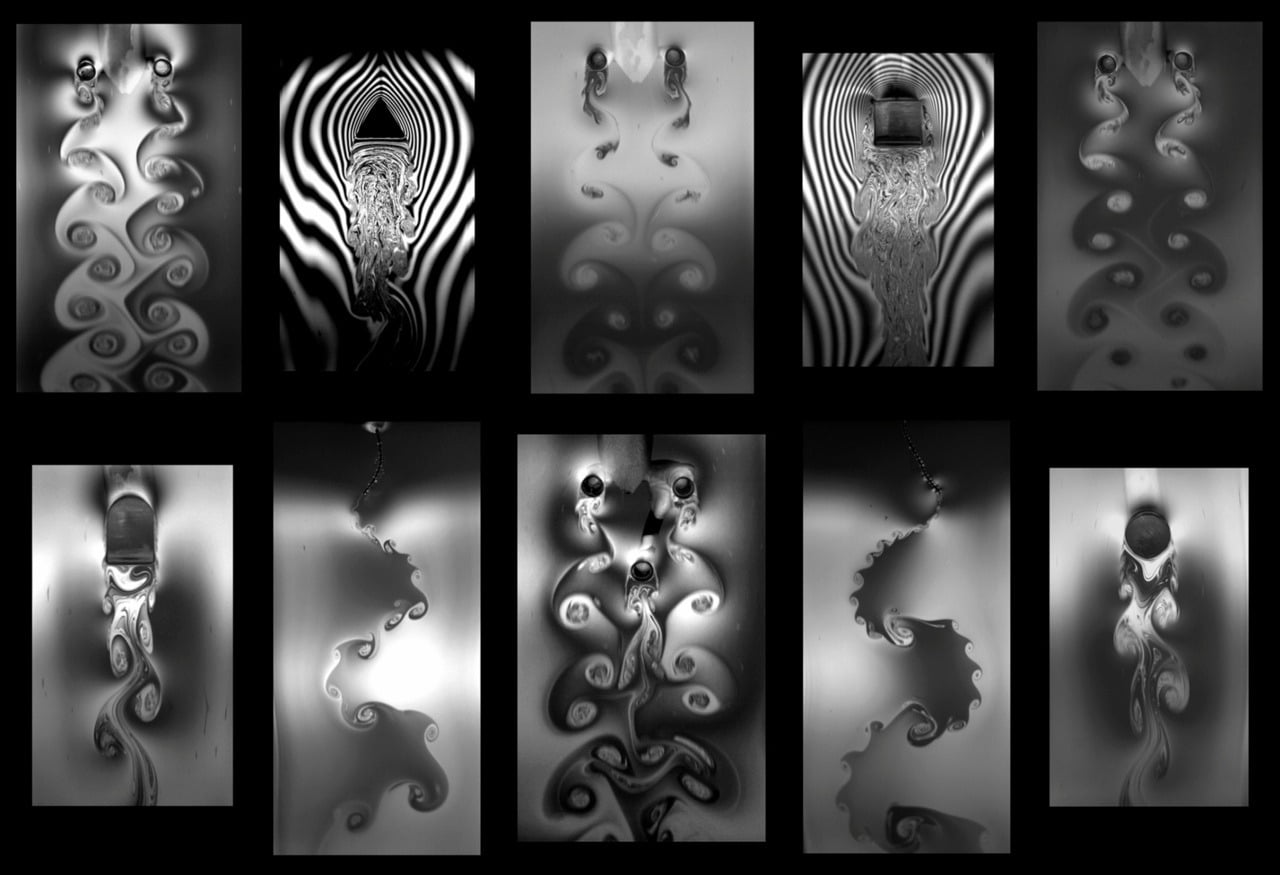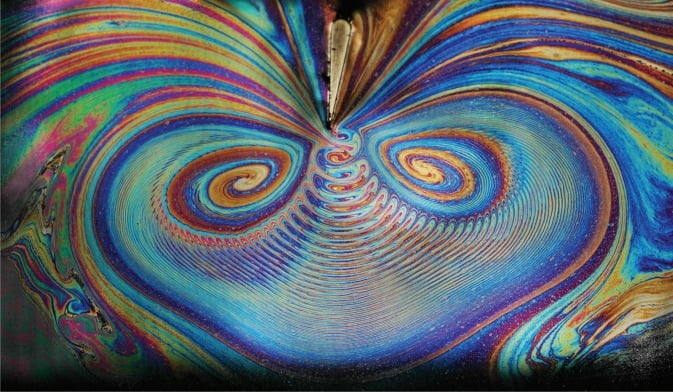The flapping of flexible objects like flags have long fascinated mankind. The figure above from Shelley and Zhang 2011 shows several possible flapping states. In (a) a thread immersed in a running soap film displays the standard von Karman vortex street of shed vortices in its wake. Parts (b) and © show the thread in coherent flapping motion; (b) shows an snapshot of the flapping thread in the soap film whereas © is a timelapse of the thread showing its full range of motion. Image (d) shows the effects of a higher flow speed–the flapping motion becomes aperiodic. Image (e) shows a stiff metal wire bent into the shape of a flapping filament; note the strong boundary layer separation around the wire compared to the thread in Image (b). As one might expect, the drag on the unflapping wire is significantly greater than the drag on the flapping thread. (Image credit: M. Shelley and J. Zhang, Shelley and Zhang 2011)
Tag: soap film

Soap Film Loops
Here’s a fun demonstration of the effects of surface tension. If a loop of thread is dropped onto a soap film, as shown above, popping the soap film inside the thread will pull the thread into a circle. This is because the surface tension of the soap film outside the thread is reacting to the sudden loss of the balancing force exerted by surface tension inside the thread loop. Surface tension arises from intermolecular forces in a fluid. Because those forces are in balance except along the interface of a fluid–where the fluid molecules are not completely surrounded by identical molecules–there is a net force exerted at the surface.

Flapping Wakes
As a flapping object moves through a fluid, many patterns of vortices can form in its wake. The familiar von Karman vortex street, so often seen in clouds or behind cylinders, is only the beginning. In the photo above, a symmetric foil flaps in a vertical soap film; as the amplitude and frequency of the oscillation varies, the wake patterns it produces change dramatically. From left to right, a) a von Karman wake; b) an inverted von Karman wake; c) a 2P wake, in which two vortex pairs are shed with each cycle; d) a 2P+2S wake, in which two vortex pairs and two single vortices are shed per cycle; e) a 4P wake; and f) a 4P+2S wake. See some of these flows in action in these videos. (Photo credit: T. Schnipper et al.)

Bursting Bubbles
Sometimes bursting one bubble just leads to more bubbles. This high-speed video shows how popping a bubble sitting on a fluid surface can lead to a ring of daughter bubbles. When the surface of the bubble is ruptured, filaments of the liquid that made up the surface are drawn back toward the pool by surface tension, trapping small pockets of the air that had been inside the bubble. A dimple forms on the surface and rebounds as a jet that lacks the kinetic energy to eject droplets. Watch as the jet returns to the interface, and you will notice the tiny bubbles around it. At 56 ms, one of the daughter bubbles on the left bursts. See Nature for more. (Video credit: J. Bird et al)

Soap Film Breakup
This high-speed video shows a soap film formed across two rings and its deformation and breakup as the two rings are pulled apart. As the rings get further apart, surface tension deforms the soap film until the distance is too great to continue sustaining that shape. The film breaks into two–a sheet of soap film in each ring–and a little satellite bubble. Note the similarities in breakup between this soap film and a thin liquid column or water from a faucet.

Soap Bubble Burst
High-speed video of a soap bubble being popped reveals the directionality of the process. Like a the rubber of a bursting balloon, the soap film rushes away from the point of rupture, disintegrating as the information about a sudden lack of surface tension is propagated across the remaining film surface. In this regard, it is much like what happens when you drop a slinky toy.

Soap Film Flow Viz
Flowing soap films provide an educational and beautiful method for visualizing the wakes of objects in two-dimensional flows. High-speed photography highlights the interference patterns on the soap film, providing detail without the necessity for the particulate tracking of other flow visualization methods. Highlights here include wakes behind bluff bodies, interacting cylinders, and flapping flags. (pdf) #

Butterfly Soap Spiral
A stationary soap film disturbed by a flapping foil (seen in the top center) creates a butterfly-like double spiral roll. Two vortices form at the tip of the foil each time it changes direction; look carefully and you can see those tiny vortices all the way through the spirals. (From the 2010 Gallery of Fluid Motion; pdf)




